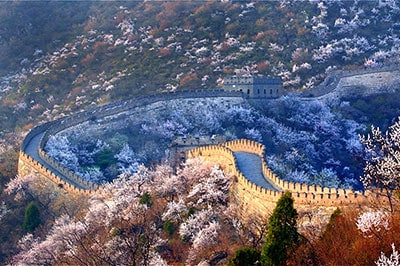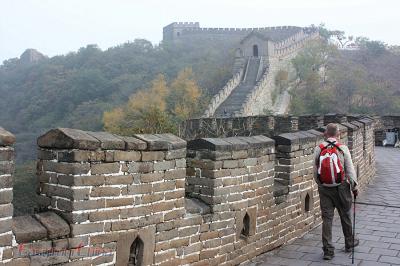What is in the Great Wall of China?
The Great Wall, an outstanding representation of the wisdom and labor achievements of the ancient Chinese people, is also one of the important symbols of Chinese culture. The name of the Great Wall originates from its function, i.e. the a massive wall built to prevent enemy invasion.
What is in the Great Wall of China: Fortifications, Walls, watchtowers...
A series of fortifications that spans over 13,000 miles across northern China, the Great Wall is also one of the most iconic landmarks on Earth. The wall was built over a period of two millenniums, with construction beginning in the 7th century BC and continuing through the Ming dynasty (1368-1644).
Ancient Core Military Defences
The Great Wall is made primarily of brick, tamped earth, stone, and wood. The wall is up to 30 feet tall and up to 15 feet wide at the base. This magnificent military defense structure has stood the test of time and remains one of the most visited historical sites in the world.
The Great Wall is mainly distributed in Hebei, Beijing, Tianjin, Shanxi, Shaanxi, Gansu, Inner Mongolia, Heilongjiang, Jilin, Liaoning, Shandong, Henan, Qinghai, Ningxia, and Xinjiang, a total of 15 provinces, autonomous regions, and municipalities directly under the central government. The length in Hebei Province is more than 2,000 kilometers, and the length in Shaanxi Province is 1,838 kilometers. According to the results of a nationwide survey of the Great Wall by the Department of Cultural Heritage and Mapping, the total length of the Ming Great Wall is 8,851.8 km, and the Qin and Han and early Great Wall exceeds 10,000 km, for a total length of more than 21,000 km. >> Learn more about How Long is the Great Wall of China
The extant Great Wall cultural relics proper include various types of remains such as the walls, watchtowers, beacon towers, trenches, boundary trenches, barracks, stables, monolithic buildings, customs forts, and related facilities, totaling more than 43,000 sites (blocks/sections).
>> Recommended Great Wall of China Tours:
Beacon System
The Great Wall beacon towers, as an important part of the defence system of the Great Wall of China in ancient times, also played multiple roles of information transmission, alarm system and psychological tactics.
When an enemy invasion or other emergencies were detected, the beacons would be lit quickly and signals would be transmitted to other beacons and the defenders through fire or smoke. During the Ming Dynasty, the alarm system of the beacon towers was more perfect, through lighting different numbers and colours of smoke and combining with the sound of cannons and other signals to transmit more detailed and complicated military intelligence, such as the number of enemy troops and the direction of attack.
The tall and bright fires of the beacon towers not only served as practical alarms, but also had a certain psychological and tactical effect. When the enemy found the beacon lit on the Great Wall, it meant that they had been discovered and faced determined resistance.
Underground Great Wall
In Bozhou, Anhui Province, there is a well-preserved ancient underground military facility known as the “Underground Great Wall”. This massive underground complex was built by Cao Cao around the 3rd century AD, 17 centuries ago. Surprisingly, it lay dormant for more than 700 years before it was discovered (during the Anti-Japanese War).
As the most well-preserved underground military facility, this underground wall is not only magnificent in scale, but also contains a great deal of important information about ancient military defences, providing valuable physical information for the study of ancient Chinese military history.
What does the Great Wall of China Look like Today?

The Great Wall is not just a wall but a complex system of fortifications that includes many different types of structures. Today some sections of the wall are basically sound, some have been restored to their former glory, while others are in ruins.
The Great Wall of China is shortening, with the total length of the Ming Wall and ruins no longer exceeding 2,500 kilometres. Many of the beacons have lost their brickwork, some of the walls are leaning, and some have been hollowed out by the elements, leaving several large holes that could collapse in one rainstorm.
The Great Wall has been damaged by nature, and in many places it has been subjected to natural weathering and is on the verge of collapse without being repaired. At the same time, with the rapid increase in population, the massive launch of various construction projects and the blind development of local economies, mankind has posed an even more serious threat to the Great Wall.
Iconic Great Wall Landmarks
The first pass in the world, Shanhai Pass functioned as both an archery tower and a city gate. Jiayuguan Pass is the best-preserved ancient military fortress and a key fortress on the Silk Road. You can find the acoustic design on wall with the “rock-striking swallows”.
In Beijing, Great Wall of China at Mutianyu is the only three-hole enemy tower. At Badaling Great Wall, Chairman Mao inscribed “One who fails to reach the Great Wall is not a hero”. The Jiankou Great Wall Wall is one of the most dangerous sections of the Great Wall, with its iconic “Eagle's Flight”. Simatai Great Wall is the only Great Wall that retains the original appearance of the Ming Dynasty, with the Wangjing Tower as its symbol. At the most beautiful Jinshanling Great Wall, there is a Treasury Building and Ming Dynasty brick carvings. The base of Juyongguan is inscribed with scriptures in six scripts, including Sanskrit, Tibetan and Xixia, which is solid evidence of the multicultural fusion during the Yuan Dynasty.
>> Recommended Beijing tours to Great Wall: